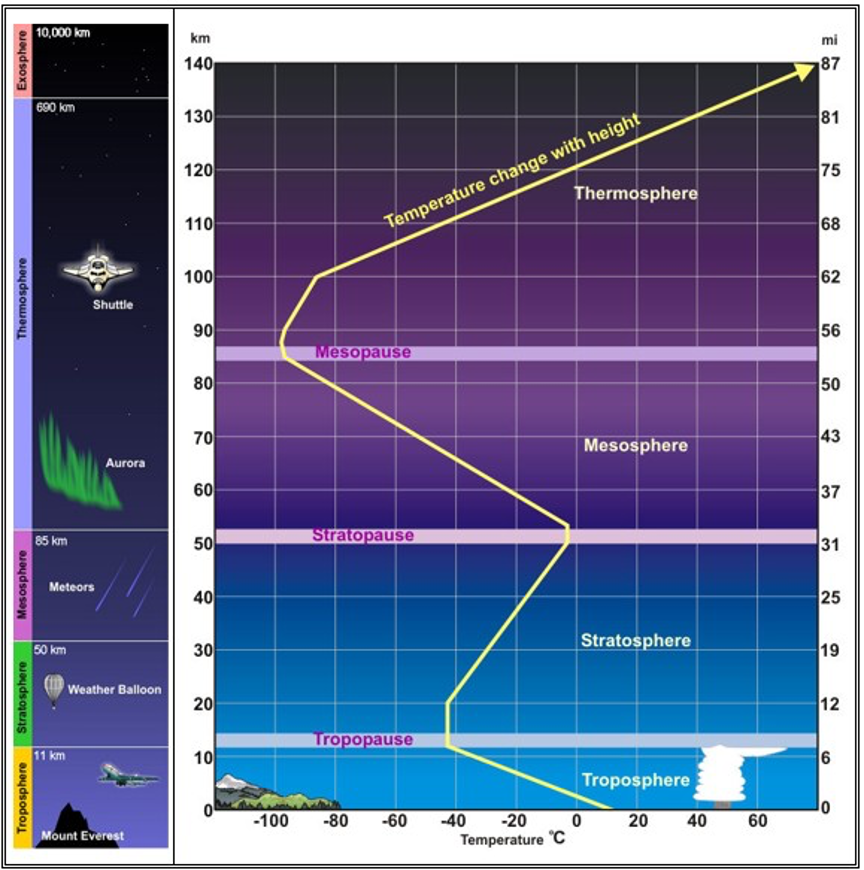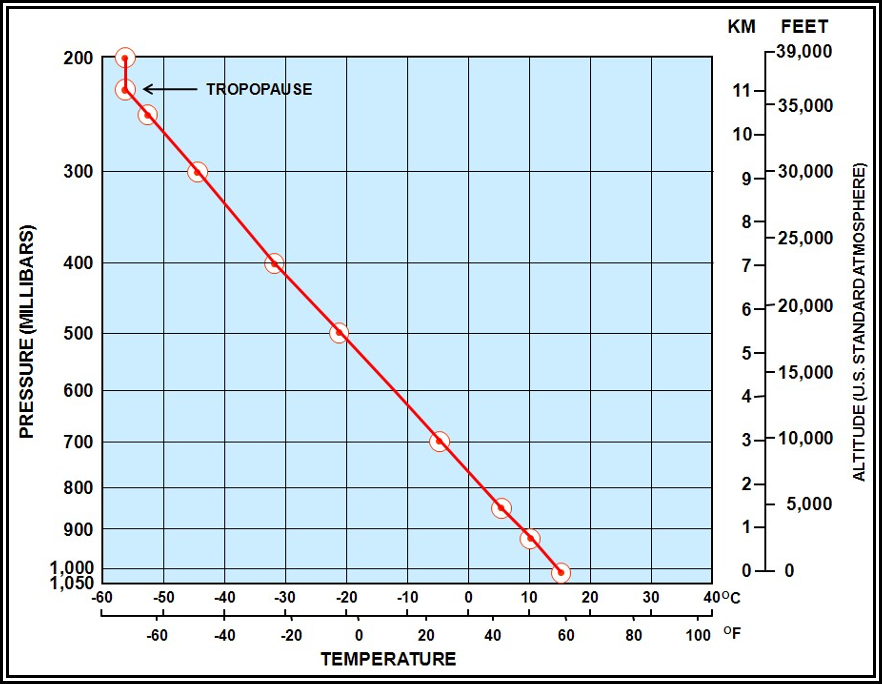Introduction
The Earth’s atmosphere is a cloud of gas and suspended solids extending from the surface out many thousands of miles, becoming thinner with distance, but always held by the Earth’s gravitational pull. The atmosphere is made up of layers surrounding the Earth that holds the air that people breathe, protects us from outer space, and holds moisture (e.g., vapor, clouds, and precipitation), gases, and tiny particles. In short, the atmosphere is the protective bubble that people live in.
This chapter covers the atmosphere’s composition and vertical structure and the standard atmosphere.
Composition
The Earth’s atmosphere consists of numerous gases (see Table 4-1) with nitrogen, oxygen, argon, and carbon dioxide making up 99.998 percent of all gases. Nitrogen, by far the most common, dilutes oxygen and prevents rapid burning at the Earth’s surface. Living things need it to make proteins. Oxygen is used by all living things and is essential for respiration. Plants use carbon dioxide to make oxygen. Carbon dioxide also acts as a blanket and prevents the escape of heat to outer space. Table . Composition of a Dry Earth’s Atmosphere.
| Gas | Symbol | Content (by Volume) |
| Nitrogen | N2 | 78.084% |
| Oxygen | O2 | 20.947% |
| Argon | Ar | 0.934% |
| Carbon Dioxide | CO2 | 0.033% |
| Neon | Ne | 18.20 parts per million |
| Helium | He | 5.20 parts per million |
| Methane | CH4 | 1.75 parts per million |
| Krypton | Kr | 1.10 parts per million |
| Sulfur dioxide | SO2 | 1.00 parts per million |
| Hydrogen | H2 | 0.50 parts per million |
| Nitrous Oxide | N2O | 0.50 parts per million |
| Xenon | Xe | 0.09 parts per million |
| Ozone | O3 | 0.07 parts per million |
| Nitrogen Dioxide | NO2 | 0.02 parts per million |
| Iodine | I2 | 0.01 parts per million |
| Carbon Monoxide | CO | trace |
| Ammonia | NH3 | trace |
| Note: The atmosphere always contains some water vapor in amounts varying from trace to about 4 percent by volume. As water vapor content increases, the other gases decrease proportionately. | ||
Weather (the state of the atmosphere at any given time and place) strongly influences daily routine as well as general life patterns. Virtually all of our activities are affected by weather, but, of all of our endeavors, perhaps none more so than aviation.
Air Parcel
An air parcel is an imaginary volume of air to which any or all of the basic properties of atmospheric air may be assigned. A parcel is large enough to contain a very large number of molecules, but small enough so that the properties assigned to it are approximately uniform. It is not given precise numerical definition, but a cubic centimeter of air might fit well into most contexts where air parcels are discussed. In meteorology, an air parcel is used as a tool to describe certain atmospheric processes, and air parcels will be referred to in this handbook.
Vertical Structure
The Earth’s atmosphere is subdivided into five concentric layers (see Figure 4-1) based on the vertical profile of average air temperature changes, chemical composition, movement, and density. Each of the five layers is topped by a pause, where the maximum changes in thermal characteristics, chemical composition, movement, and density occur.
Troposphere
The troposphere begins at the Earth’s surface and extends up to about 11 kilometers (km) (36,000 ft) high. This is where people live. As the gases in this layer decrease with height, the air becomes thinner. Therefore, the temperature in the troposphere also decreases with height. Climbing higher, the temperature drops from about 15 degrees Celsius (°C) (59 degrees Fahrenheit (°F)) to -56.5 °C (-70 °F). Almost all weather occurs in this region.
The vertical depth of the troposphere varies due to temperature variations, which are closely associated with latitude and season. It decreases from the Equator to the poles, and is higher during summer than in winter. At the Equator, it is around 18–20 km (11–12 miles (mi)) high, at 50° N and 50° S latitude, 9 km (5.6 mi), and at the poles, 6 km (3.7 mi) high.
The lowest portion of the troposphere is known as the planetary boundary layer. The height of the boundary layer varies depending on terrain and time of day, and is directly affected by surface heating and cooling. It has an important role in transporting heat and moisture into the atmosphere. The transition boundary between the troposphere and the layer above is called the tropopause. Both the tropopause and the troposphere are known as the lower atmosphere.
Stratosphere
The stratosphere extends from the tropopause up to 50 km (31 mi) above the Earth’s surface. This layer holds 19 percent of the atmosphere’s gases, but very little water vapor.
Temperature increases with height as radiation is increasingly absorbed by oxygen molecules, leading to the formation of ozone. The temperature rises from an average -56.6 °C (-70 °F) at the tropopause to a maximum of about -3 °C (27 °F) at the stratopause due to this absorption of ultraviolet radiation. The increasing temperature also makes it a calm layer, with movements of the gases being slow.
Commercial aircraft often cruise in the lower stratosphere to avoid atmospheric turbulence and convection in the troposphere. Severe turbulence during the cruise phase of flight can be caused by the convective overshoot of thunderstorms from the troposphere below. The disadvantages of flying in the stratosphere can include increased fuel consumption due to warmer temperatures, increased levels of radiation, and increased concentration of ozone.
Mesosphere
The mesosphere extends from the stratopause to about 85 km (53 mi) above the Earth. The gases, including the number of oxygen molecules, continue to become thinner and thinner with height. As such, the effect of the warming by ultraviolet radiation also becomes less and less pronounced, leading to a decrease in temperature with height. On average, temperature decreases from about -3 °C (27 °F) to as low as -100 °C (-148 °F) at the mesopause. However, the gases in the mesosphere are thick enough to slow down meteorites hurtling into the atmosphere, where they burn up, leaving fiery trails in the night sky.
Thermosphere
The thermosphere extends from the mesopause to 690 km (430 mi) above the Earth. This layer is known as the upper atmosphere.
The gases of the thermosphere become increasingly thin compared to the mesosphere. As such, only the higher energy ultraviolet and x ray radiation from the Sun is absorbed. But because of this absorption, the temperature increases with height and can reach as high as 2,000 °C (3,600 °F) near the top of this layer.
Despite the high temperature, this layer of the atmosphere would still feel very cold to our skin because of the extremely thin air. The total amount of energy from the very few molecules in this layer is not sufficient enough to heat our skin.
Exosphere
The exosphere is the outermost layer of the atmosphere and extends from the thermopause to 10,000 km (6,200 mi) above the Earth. In this layer, atoms and molecules escape into space and satellites orbit the Earth. The transition boundary that separates the exosphere from the thermosphere is called the thermopause.

The regions of the stratosphere and the mesosphere, along with the stratopause and mesopause, are called the middle atmosphere. The transition boundary that separates the stratosphere from the mesosphere is called the stratopause.
Figure . Vertical Structure of the Atmosphere
The Standard Atmosphere
Continuous fluctuations of atmospheric properties create problems for engineers and meteorologists who need a fixed standard for reference. To solve this problem, they defined a standard atmosphere, which represents an average of conditions throughout the atmosphere for all latitudes, seasons, and altitudes. Standard atmosphere is a hypothetical vertical distribution of atmospheric temperature, pressure, and density that, by international agreement, is taken to be representative of the atmosphere for purposes of pressure altimeter calibrations, aircraft performance calculations, aircraft and missile design, ballistic tables, etc. Weather-related processes are generally referenced to the standard atmosphere, as are the examples in this handbook.
Table . Selected Properties of the Standard Atmosphere
| Property | Metric Units | English Units |
| Sea level pressure | 1013.25 hectopascals (hPa) | 29.92 inches of mercury (inHg) |
| Sea level temperature | 15 °C | 59 °F |
| Lapse rate of temperature in the troposphere | 6.5 °C/1,000 m | 3.57 °F/1,000 ft |
| Pressure altitude of the tropopause | 11,000 m | 36,089 ft |
| Temperature at the tropopause | -56.5 °C | -69.7 °F |
| Note: 1 hectopascal = 1 millibar. |

Figure . U.S. Standard Atmosphere Within the Troposphere





